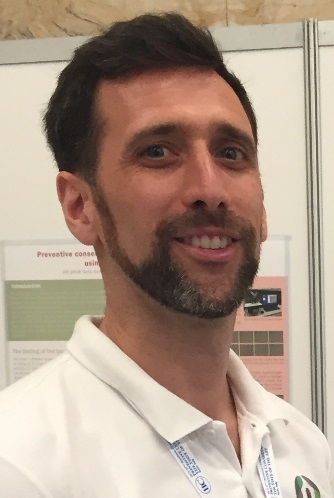Air pressure testing of museum microclimates for conserving metals & building energy
Attempting to use museum microclimates for tailoring care of collections and saving building energy can be a very rewarding or a very frustrating activity. This one-day workshop will highlight the “why” and “how” of using pressure methods to improve the probability of success, and cut the time taken to get there.
Air – with its moisture and pollutants – exchanged by museum showcases and storage cabinets is mostly driven by spatial differences and temporal changes in air pressure. Yet the understanding, or measurement, of air pressure is rarely used for conservation of heritage in the many uninhabited and unpowered (passive) enclosures used by museums.
Participants will first learn about the important roles air pressure play – including indirect environmental and compositional effects – in the physics of air moving to and from enclosures, so they can more effectively and efficiently conserve:
- archaeological iron and copper by keeping dried air in
- silver by keeping tarnishing pollutants out
- lead by venting off aggressive volatile organic compounds
- energy for heating, cooling, ventilating and de/humidifying galleries and stores.
Participants will then diagnose, and troubleshoot, the construction quality of enclosures by:
- measuring airtightness of a showcase by constant pressure
- measuring airtightness of a microclimate frame by pressure decay
- finding all leakage (outlets and inlets) with an ecological tracer gas by overpressure.
Short bio
 James Crawford first trained in heritage conservation at the University of Canberra (Australia) and Institute for Conservation and Management of Cultural Heritage (Malta). He worked as a conservator of archaeology, architecture and sculpture in Australia and France. While at Heritage Malta he participated in European Union research improving conservation methods for metallic works around the Mediterranean.
James Crawford first trained in heritage conservation at the University of Canberra (Australia) and Institute for Conservation and Management of Cultural Heritage (Malta). He worked as a conservator of archaeology, architecture and sculpture in Australia and France. While at Heritage Malta he participated in European Union research improving conservation methods for metallic works around the Mediterranean.
James now collaborates with museums and industry to develop ways to sustainably conserve heritage collections. He specialises in energy efficient and time-saving collections care. This is typically achieved with greater control of the micro-environments found inside passive display cases and storage units: being much smaller and less energy-demanding than rooms.
His physics thesis at the University of Warwick (United Kingdom) – “Atmospheric Microclimates: damaging & protecting indoor cultural heritage materials” – investigated the interventive conservation of lead metal through surface protection, and the preventive conservation of diverse materials through the measurement and control of enclosure airtightness.
James co-represents the UK during the drafting of a European standard – EN 15999-2 – on the technical aspects of specifying new museum display cases.
Contact information
Sustainable Microclimates Ltd, Innovation Birmingham Campus, Faraday Wharf, Holt Street Birmingham Science Park, Aston, Birmingham, West Midlands B7 4BB, United Kingdom
james@sustainablemicroclimates.com
http://www.sustainablemicroclimates.com
Tel: +44 (0) 3301 200 300.


